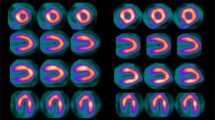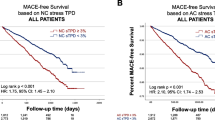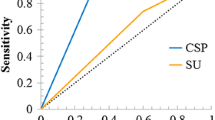Abstract
Background
Obesity is a common source of artifact on conventional SPECT myocardial perfusion imaging (MPI). We evaluated image quality and diagnostic performance of high-efficiency (HE) cadmium-zinc-telluride parallel-hole SPECT MPI for coronary artery disease (CAD) in obese patients.
Methods and Results
118 consecutive obese patients at three centers (BMI 43.6 ± 8.9 kg·m−2, range 35-79.7 kg·m−2) had upright/supine HE-SPECT and invasive coronary angiography > 6 months (n = 67) or low likelihood of CAD (n = 51). Stress quantitative total perfusion deficit (TPD) for upright (U-TPD), supine (S-TPD), and combined acquisitions (C-TPD) was assessed. Image quality (IQ; 5 = excellent; < 3 nondiagnostic) was compared among BMI 35-39.9 (n = 58), 40-44.9 (n = 24) and ≥45 (n = 36) groups. ROC curve area for CAD detection (≥50% stenosis) for U-TPD, S-TPD, and C-TPD were 0.80, 0.80, and 0.87, respectively. Sensitivity/specificity was 82%/57% for U-TPD, 74%/71% for S-TPD, and 80%/82% for C-TPD. C-TPD had highest specificity (P = .02). C-TPD normalcy rate was higher than U-TPD (88% vs 75%, P = .02). Mean IQ was similar among BMI 35-39.9, 40-44.9 and ≥45 groups [4.6 vs 4.4 vs 4.5, respectively (P = .6)]. No patient had a nondiagnostic stress scan.
Conclusions
In obese patients, HE-SPECT MPI with dedicated parallel-hole collimation demonstrated high image quality, normalcy rate, and diagnostic accuracy for CAD by quantitative analysis of combined upright/supine acquisitions.





Similar content being viewed by others
References
Jensen MD, Ryan DH, Apovian CM, Ard JD, Comuzzie AG, Donato KA et al. 2013 AHA/ACC/TOS guideline for the management of overweight and obesity in adults: a report of the American College of Cardiology/American Heart Association Task Force on Practice Guidelines and The Obesity Society. J Am Coll Cardiol 2014;63:2985–3023.
DePuey EG. How to detect and avoid myocardial perfusion SPECT artifacts. J Nucl Med 1994;35:699-702.
DePuey EG, Garcia EV. Optimal specificity of thallium-201 SPECT through recognition of imaging artifacts. J Nucl Med 1989;30:441-9.
Slomka P, Patton J, Berman D, Germano G. Advances in technical aspects of myocardial perfusion SPECT imaging. J Nucl Cardiol 2009;16:255-76.
Nakazato R, Tamarappoo BK, Kang X, Wolak A, Kite F, Hayes SW, et al. Quantitative upright-supine high-speed SPECT myocardial perfusion imaging for detection of coronary artery disease: Correlation with invasive coronary angiography. J Nucl Med 2010;51:1724-31.
Duvall WL, Sweeny JM, Croft LB, Barghash MH, Kulkarni NK, Guma KA, et al. Comparison of high efficiency CZT SPECT MPI to coronary angiography. J Nucl Cardiol 2011;18:595-604.
Gimelli A, Bottai M, Genovesi D, Giorgetti A, Di Martino F, Marzullo P. High diagnostic accuracy of low-dose gated-SPECT with solid-state ultrafast detectors: Preliminary clinical results. Eur J Nucl Med Mol Imaging 2012;39:83-90.
Fiechter M, Gebhard C, Fuchs TA, Ghadri JR, Stehli J, Kazakauskaite E, et al. Cadmium-zinc-telluride myocardial perfusion imaging in obese patients. J Nucl Med 2012;53:1401-6.
Gimelli A, Bottai M, Giorgetti A, Genovesi D, Filidei E, Marzullo P. Evaluation of ischaemia in obese patients: Feasibility and accuracy of a low-dose protocol with a cadmium-zinc telluride camera. Eur J Nucl Med Mol Imaging 2012;39:1254-61.
Sturm R. Increases in morbid obesity in the USA: 2000-2005. Public Health 2007;121:492-6.
Sharir T, Slomka P, Hayes S, DiCarli M, Ziffer J, Martin W, et al. Multicenter trial of high-speed versus conventional single-photon emission computed tomography imaging: Quantitative results of myocardial perfusion and left ventricular function. J Am Coll Cardiol 2010;55:1965-74.
Berman D, Kang X, Tamarappoo B, Wolak A, Hayes S, Nakazato R, et al. Stress thallium-201/rest technetium-99m sequential dual isotope high-speed myocardial perfusion imaging. JACC Cardiovasc Imaging 2009;2:273-82.
Nakazato R, Berman DS, Hayes SW, Fish M, Padgett R, Xu Y, et al. Myocardial perfusion imaging with a solid-state camera: Simulation of a very low dose imaging protocol. J Nucl Med 2013;54:373-9.
Patton J, Slomka P, Germano G, Berman D. Recent technologic advances in nuclear cardiology. J Nucl Cardiol 2007;14:501-13.
Sharir T, Ben-Haim S, Merzon K, Prochorov V, Dickman D, Berman D. High-speed myocardial perfusion imaging initial clinical comparison with conventional dual detector anger camera imaging. JACC Cardiovasc Imaging 2008;1:156-63.
Gambhir S, Berman D, Ziffer J, Nagler M, Sandler M, Patton J, et al. A novel high-sensitivity rapid-acquisition single-photon cardiac imaging camera. J Nucl Med 2009;50:635-43.
Slomka PJ, Nishina H, Berman DS, Akincioglu C, Abidov A, Friedman JD, et al. Automated quantification of myocardial perfusion SPECT using simplified normal limits. J Nucl Cardiol 2005;12:66-77.
Shaw LJ, Berman DS, Maron DJ, Mancini GB, Hayes SW, Hartigan PM, et al. Optimal medical therapy with or without percutaneous coronary intervention to reduce ischemic burden: Results from the Clinical Outcomes Utilizing Revascularization and Aggressive Drug Evaluation (COURAGE) trial nuclear substudy. Circulation 2008;117:1283-91.
Berman D, Kiat H, Friedman J, Wang F, van Train K, Matzer L, et al. Separate acquisition rest thallium-201/stress technetium-99m sestamibi dual-isotope myocardial perfusion single-photon emission computed tomography: A clinical validation study. J Am Coll Cardiol 1993;22:1455-64.
Hachamovitch R, Hayes S, Friedman J, Cohen I, Berman D. Comparison of the short-term survival benefit associated with revascularization compared with medical therapy in patients with no prior coronary artery disease undergoing stress myocardial perfusion single photon emission computed tomography. Circulation 2003;107:2900-7.
Nakazato R, Berman DS, Gransar H, Hyun M, Miranda-Peats R, Kite FC, et al. Prognostic value of quantitative high-speed myocardial perfusion imaging. J Nucl Cardiol 2012;19:1113-23.
Hendel R, Berman D, Di Carli M, Heidenreich P, Henkin R, Pellikka P, et al. ACCF/ASNC/ACR/AHA/ASE/SCCT/SCMR/SNM 2009 appropriate use criteria for cardiac radionuclide imaging: A report of the American College of Cardiology Foundation Appropriate Use Criteria Task Force, the American Society of Nuclear Cardiology, the American College of Radiology, the American Heart Association, the American Society of Echocardiography, the Society of Cardiovascular Computed Tomography, the Society for Cardiovascular Magnetic Resonance, and the Society of Nuclear Medicine. J Am Coll Cardiol 2009;53:2201-29.
Berman D, Kang X, Gransar H, Gerlach J, Friedman J, Hayes S, et al. Quantitative assessment of myocardial perfusion abnormality on SPECT myocardial perfusion imaging is more reproducible than expert visual analysis. J Nucl Cardiol 2009;16:45-53.
Slomka P, Berman D, Germano G. Quantification of serial changes in myocardial perfusion. J Nucl Med 2004;45:1978-80.
Acknowledgments
This research was partially supported in part by Grant R01-HL089765 from the National Heart, Lung, and Blood Institute/National Institutes of Health (NHLBI/NIH). Its contents are solely the responsibility of the authors and do not necessarily represent the official views of the NHLBI.
Disclosure
Dr Piotr Slomka, Guido Germano, and Dr Daniel Berman receive royalties from the software employed in the study. Dr Mathews Fish is a medical consultant of Spectrum-Dynamics. Dr Daniel Berman is a shareholder in Spectrum-Dynamics. All others disclose no conflict of interest.
Author information
Authors and Affiliations
Corresponding author
Additional information
See related editorial, doi:10.1007/s12350-014-0005-3.
Rights and permissions
About this article
Cite this article
Nakazato, R., Slomka, P.J., Fish, M. et al. Quantitative high-efficiency cadmium-zinc-telluride SPECT with dedicated parallel-hole collimation system in obese patients: Results of a multi-center study. J. Nucl. Cardiol. 22, 266–275 (2015). https://doi.org/10.1007/s12350-014-9984-3
Received:
Accepted:
Published:
Issue Date:
DOI: https://doi.org/10.1007/s12350-014-9984-3




